Design Thinking Module: A Reflective Report on Key Learnings
VerifiedAdded on 2023/06/07
|12
|3488
|390
AI Summary
This reflective report details a student's learning journey through a Design Thinking course. It covers the gradual acquisition of skills and knowledge from lessons, discussions, and workshops. The report emphasizes the transformative impact of Design Thinking principles on problem-solving approaches at both personal and societal levels. Key concepts such as empathizing, ideating, defining, prototyping, and testing are explored, highlighting the importance of a creative mindset in every process. The report also reflects on the value of collaboration and diverse perspectives in generating innovative solutions. Activities like brainstorming sessions and analyzing business models are discussed, showcasing the practical application of Design Thinking in various contexts. The student reflects on how the course has enhanced critical thinking, spontaneity, and the ability to convert thoughts into actionable designs. The report concludes by emphasizing the importance of continuous learning, open-mindedness, and data-driven decision-making in achieving effective and innovative outcomes.

Running head: REFLECTIVE REPORT 1
Reflective Report on Design Thinking Lessons
Student’s Name
Institution Affiliation
Reflective Report on Design Thinking Lessons
Student’s Name
Institution Affiliation
Paraphrase This Document
Need a fresh take? Get an instant paraphrase of this document with our AI Paraphraser

REFLETIVE REPORT 2
Reflective Report on Design Thinking Lessons
Some of the main reasons why people go to school include the fact that school equips
a student with the skills that help unlock various opportunities necessary for improving the
living standards. The lessons students go through in school, whatever the level of education,
are aimed at making the student be a responsible member of the society when he or she grows
into adulthood (Bennett, Agostinho, & Lockyer, 2016). Different subjects instil different
skills in learners and help them achieve varying steps in life even though skills from some
parallel areas of studies overlap. Proper application of such skills enable learners become
professionals in related fields and industries. With such skills, a learner makes huge steps
towards improving his or her living standard and those of people who depend on him or her
(Ding, 2018). Design Thinking is one of the popular concepts learned in schools and its
application in real life situation helps in finding solutions to various problems and challenges
we face in daily operations.
The skills and knowledge acquired from a given subject are obtained gradually along
the course of the learning process. As in my case, the concepts I have acquired from the
Design Thinking lessons, discussions and workshops have been gained over a gradual
continuous process covering the weeks in term (Bhardwaj, Crocker, Sims, & Wang, 2018).
The activities covered during the period introduced new and life changing skills and
knowledge that have improved my perception on the process of finding a solution to
challenges I face at personal level and in the society. For instance, the first three weeks
included the introduction of the concept of Design Thinking (Bower, 2016). Discussions that
were held in the workshop changed how I view the concept of finding solution; that we
should always subject a situation to some questions such what, why, when, and how? Having
such kind of Cartesian Doubt mind helps in helps in broadening the way we understand
Reflective Report on Design Thinking Lessons
Some of the main reasons why people go to school include the fact that school equips
a student with the skills that help unlock various opportunities necessary for improving the
living standards. The lessons students go through in school, whatever the level of education,
are aimed at making the student be a responsible member of the society when he or she grows
into adulthood (Bennett, Agostinho, & Lockyer, 2016). Different subjects instil different
skills in learners and help them achieve varying steps in life even though skills from some
parallel areas of studies overlap. Proper application of such skills enable learners become
professionals in related fields and industries. With such skills, a learner makes huge steps
towards improving his or her living standard and those of people who depend on him or her
(Ding, 2018). Design Thinking is one of the popular concepts learned in schools and its
application in real life situation helps in finding solutions to various problems and challenges
we face in daily operations.
The skills and knowledge acquired from a given subject are obtained gradually along
the course of the learning process. As in my case, the concepts I have acquired from the
Design Thinking lessons, discussions and workshops have been gained over a gradual
continuous process covering the weeks in term (Bhardwaj, Crocker, Sims, & Wang, 2018).
The activities covered during the period introduced new and life changing skills and
knowledge that have improved my perception on the process of finding a solution to
challenges I face at personal level and in the society. For instance, the first three weeks
included the introduction of the concept of Design Thinking (Bower, 2016). Discussions that
were held in the workshop changed how I view the concept of finding solution; that we
should always subject a situation to some questions such what, why, when, and how? Having
such kind of Cartesian Doubt mind helps in helps in broadening the way we understand
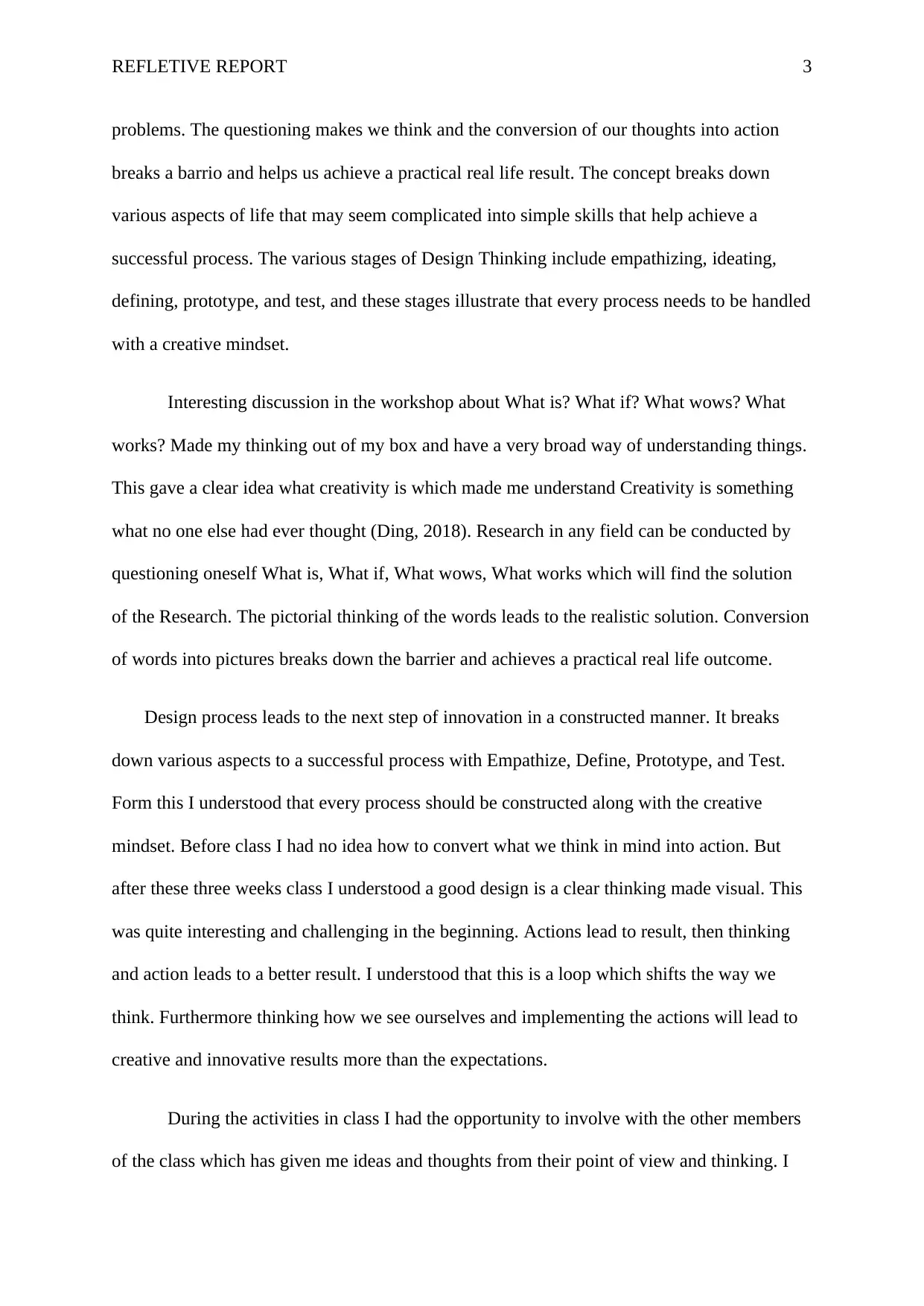
REFLETIVE REPORT 3
problems. The questioning makes we think and the conversion of our thoughts into action
breaks a barrio and helps us achieve a practical real life result. The concept breaks down
various aspects of life that may seem complicated into simple skills that help achieve a
successful process. The various stages of Design Thinking include empathizing, ideating,
defining, prototype, and test, and these stages illustrate that every process needs to be handled
with a creative mindset.
Interesting discussion in the workshop about What is? What if? What wows? What
works? Made my thinking out of my box and have a very broad way of understanding things.
This gave a clear idea what creativity is which made me understand Creativity is something
what no one else had ever thought (Ding, 2018). Research in any field can be conducted by
questioning oneself What is, What if, What wows, What works which will find the solution
of the Research. The pictorial thinking of the words leads to the realistic solution. Conversion
of words into pictures breaks down the barrier and achieves a practical real life outcome.
Design process leads to the next step of innovation in a constructed manner. It breaks
down various aspects to a successful process with Empathize, Define, Prototype, and Test.
Form this I understood that every process should be constructed along with the creative
mindset. Before class I had no idea how to convert what we think in mind into action. But
after these three weeks class I understood a good design is a clear thinking made visual. This
was quite interesting and challenging in the beginning. Actions lead to result, then thinking
and action leads to a better result. I understood that this is a loop which shifts the way we
think. Furthermore thinking how we see ourselves and implementing the actions will lead to
creative and innovative results more than the expectations.
During the activities in class I had the opportunity to involve with the other members
of the class which has given me ideas and thoughts from their point of view and thinking. I
problems. The questioning makes we think and the conversion of our thoughts into action
breaks a barrio and helps us achieve a practical real life result. The concept breaks down
various aspects of life that may seem complicated into simple skills that help achieve a
successful process. The various stages of Design Thinking include empathizing, ideating,
defining, prototype, and test, and these stages illustrate that every process needs to be handled
with a creative mindset.
Interesting discussion in the workshop about What is? What if? What wows? What
works? Made my thinking out of my box and have a very broad way of understanding things.
This gave a clear idea what creativity is which made me understand Creativity is something
what no one else had ever thought (Ding, 2018). Research in any field can be conducted by
questioning oneself What is, What if, What wows, What works which will find the solution
of the Research. The pictorial thinking of the words leads to the realistic solution. Conversion
of words into pictures breaks down the barrier and achieves a practical real life outcome.
Design process leads to the next step of innovation in a constructed manner. It breaks
down various aspects to a successful process with Empathize, Define, Prototype, and Test.
Form this I understood that every process should be constructed along with the creative
mindset. Before class I had no idea how to convert what we think in mind into action. But
after these three weeks class I understood a good design is a clear thinking made visual. This
was quite interesting and challenging in the beginning. Actions lead to result, then thinking
and action leads to a better result. I understood that this is a loop which shifts the way we
think. Furthermore thinking how we see ourselves and implementing the actions will lead to
creative and innovative results more than the expectations.
During the activities in class I had the opportunity to involve with the other members
of the class which has given me ideas and thoughts from their point of view and thinking. I
⊘ This is a preview!⊘
Do you want full access?
Subscribe today to unlock all pages.

Trusted by 1+ million students worldwide
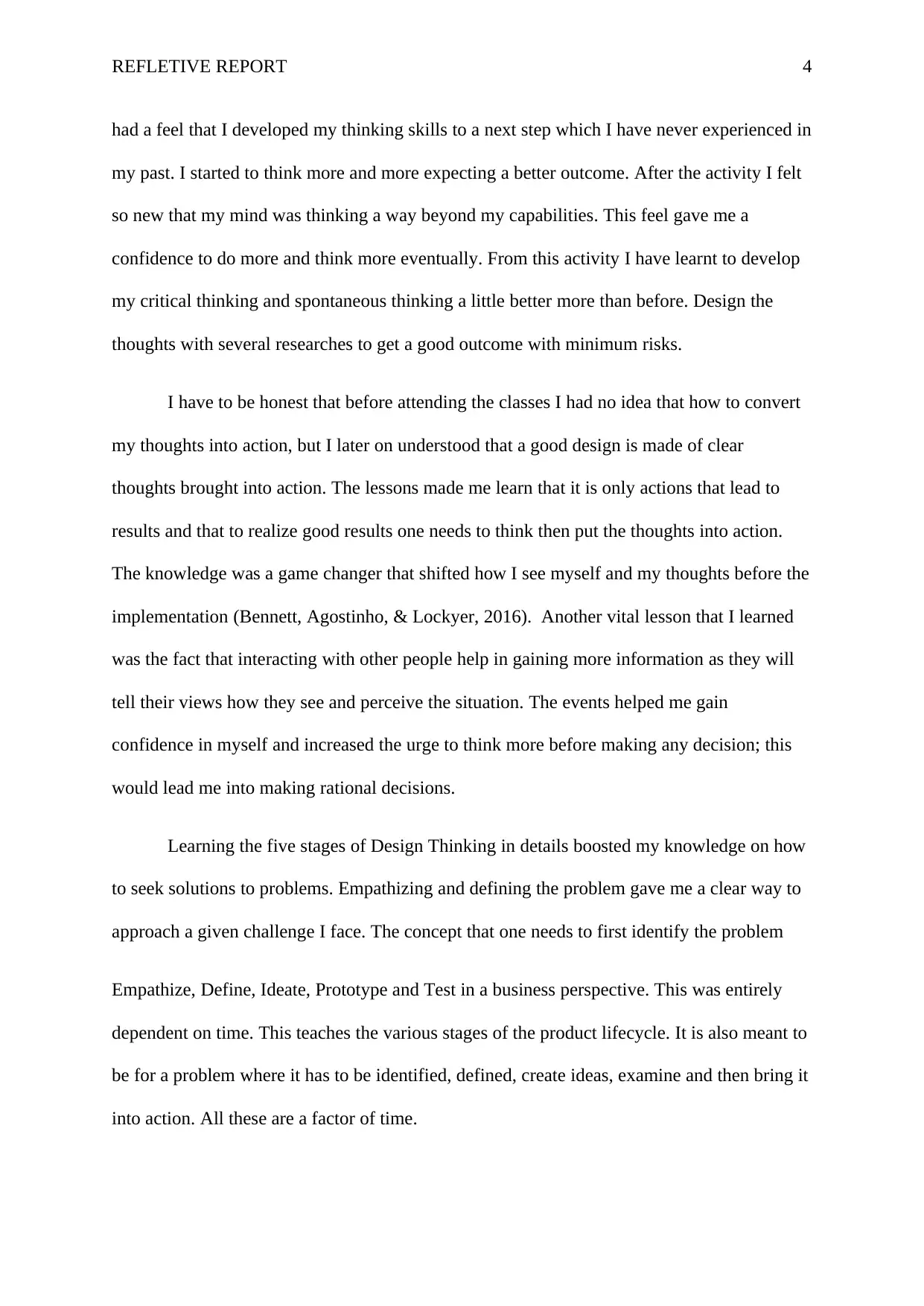
REFLETIVE REPORT 4
had a feel that I developed my thinking skills to a next step which I have never experienced in
my past. I started to think more and more expecting a better outcome. After the activity I felt
so new that my mind was thinking a way beyond my capabilities. This feel gave me a
confidence to do more and think more eventually. From this activity I have learnt to develop
my critical thinking and spontaneous thinking a little better more than before. Design the
thoughts with several researches to get a good outcome with minimum risks.
I have to be honest that before attending the classes I had no idea that how to convert
my thoughts into action, but I later on understood that a good design is made of clear
thoughts brought into action. The lessons made me learn that it is only actions that lead to
results and that to realize good results one needs to think then put the thoughts into action.
The knowledge was a game changer that shifted how I see myself and my thoughts before the
implementation (Bennett, Agostinho, & Lockyer, 2016). Another vital lesson that I learned
was the fact that interacting with other people help in gaining more information as they will
tell their views how they see and perceive the situation. The events helped me gain
confidence in myself and increased the urge to think more before making any decision; this
would lead me into making rational decisions.
Learning the five stages of Design Thinking in details boosted my knowledge on how
to seek solutions to problems. Empathizing and defining the problem gave me a clear way to
approach a given challenge I face. The concept that one needs to first identify the problem
Empathize, Define, Ideate, Prototype and Test in a business perspective. This was entirely
dependent on time. This teaches the various stages of the product lifecycle. It is also meant to
be for a problem where it has to be identified, defined, create ideas, examine and then bring it
into action. All these are a factor of time.
had a feel that I developed my thinking skills to a next step which I have never experienced in
my past. I started to think more and more expecting a better outcome. After the activity I felt
so new that my mind was thinking a way beyond my capabilities. This feel gave me a
confidence to do more and think more eventually. From this activity I have learnt to develop
my critical thinking and spontaneous thinking a little better more than before. Design the
thoughts with several researches to get a good outcome with minimum risks.
I have to be honest that before attending the classes I had no idea that how to convert
my thoughts into action, but I later on understood that a good design is made of clear
thoughts brought into action. The lessons made me learn that it is only actions that lead to
results and that to realize good results one needs to think then put the thoughts into action.
The knowledge was a game changer that shifted how I see myself and my thoughts before the
implementation (Bennett, Agostinho, & Lockyer, 2016). Another vital lesson that I learned
was the fact that interacting with other people help in gaining more information as they will
tell their views how they see and perceive the situation. The events helped me gain
confidence in myself and increased the urge to think more before making any decision; this
would lead me into making rational decisions.
Learning the five stages of Design Thinking in details boosted my knowledge on how
to seek solutions to problems. Empathizing and defining the problem gave me a clear way to
approach a given challenge I face. The concept that one needs to first identify the problem
Empathize, Define, Ideate, Prototype and Test in a business perspective. This was entirely
dependent on time. This teaches the various stages of the product lifecycle. It is also meant to
be for a problem where it has to be identified, defined, create ideas, examine and then bring it
into action. All these are a factor of time.
Paraphrase This Document
Need a fresh take? Get an instant paraphrase of this document with our AI Paraphraser
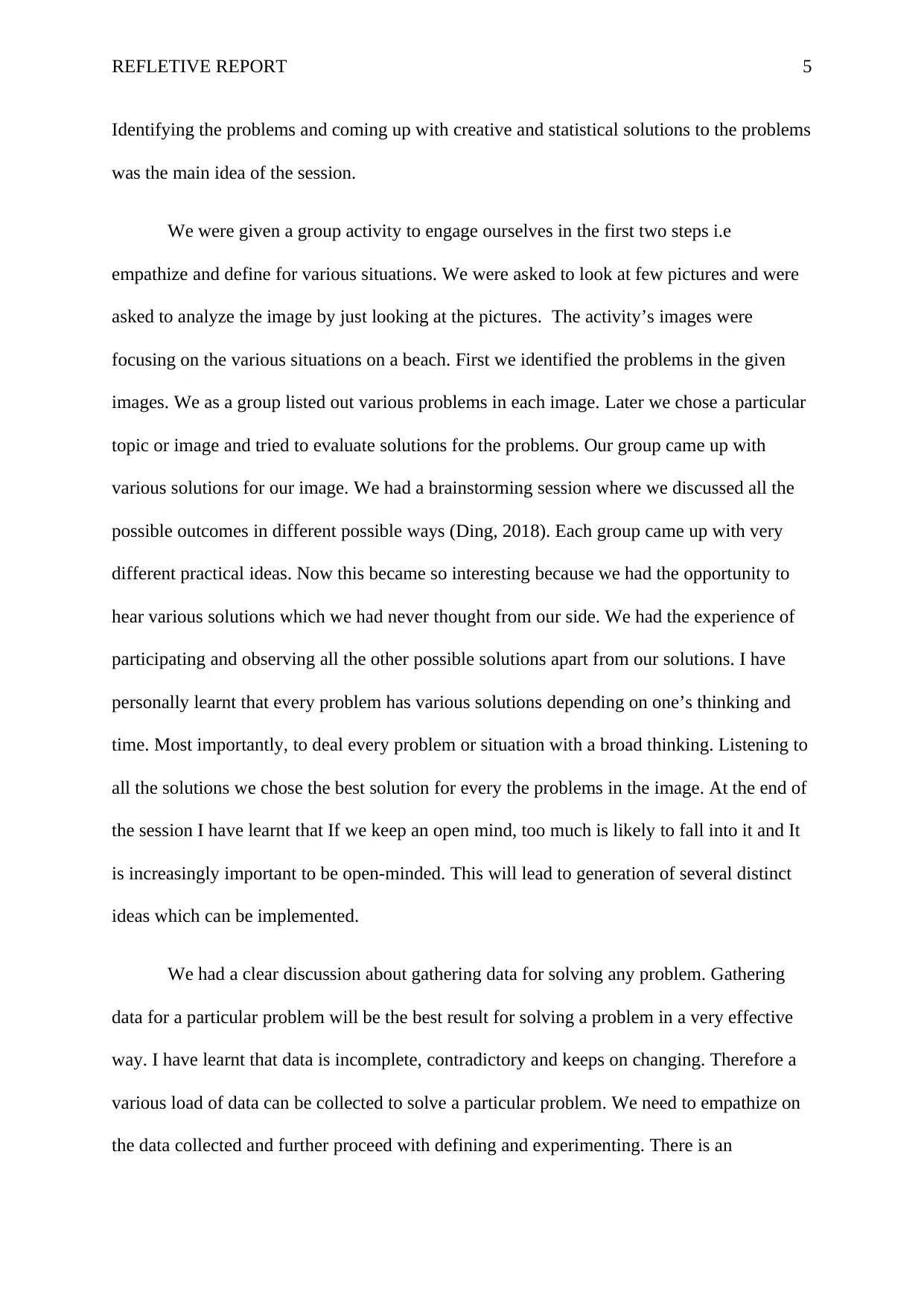
REFLETIVE REPORT 5
Identifying the problems and coming up with creative and statistical solutions to the problems
was the main idea of the session.
We were given a group activity to engage ourselves in the first two steps i.e
empathize and define for various situations. We were asked to look at few pictures and were
asked to analyze the image by just looking at the pictures. The activity’s images were
focusing on the various situations on a beach. First we identified the problems in the given
images. We as a group listed out various problems in each image. Later we chose a particular
topic or image and tried to evaluate solutions for the problems. Our group came up with
various solutions for our image. We had a brainstorming session where we discussed all the
possible outcomes in different possible ways (Ding, 2018). Each group came up with very
different practical ideas. Now this became so interesting because we had the opportunity to
hear various solutions which we had never thought from our side. We had the experience of
participating and observing all the other possible solutions apart from our solutions. I have
personally learnt that every problem has various solutions depending on one’s thinking and
time. Most importantly, to deal every problem or situation with a broad thinking. Listening to
all the solutions we chose the best solution for every the problems in the image. At the end of
the session I have learnt that If we keep an open mind, too much is likely to fall into it and It
is increasingly important to be open-minded. This will lead to generation of several distinct
ideas which can be implemented.
We had a clear discussion about gathering data for solving any problem. Gathering
data for a particular problem will be the best result for solving a problem in a very effective
way. I have learnt that data is incomplete, contradictory and keeps on changing. Therefore a
various load of data can be collected to solve a particular problem. We need to empathize on
the data collected and further proceed with defining and experimenting. There is an
Identifying the problems and coming up with creative and statistical solutions to the problems
was the main idea of the session.
We were given a group activity to engage ourselves in the first two steps i.e
empathize and define for various situations. We were asked to look at few pictures and were
asked to analyze the image by just looking at the pictures. The activity’s images were
focusing on the various situations on a beach. First we identified the problems in the given
images. We as a group listed out various problems in each image. Later we chose a particular
topic or image and tried to evaluate solutions for the problems. Our group came up with
various solutions for our image. We had a brainstorming session where we discussed all the
possible outcomes in different possible ways (Ding, 2018). Each group came up with very
different practical ideas. Now this became so interesting because we had the opportunity to
hear various solutions which we had never thought from our side. We had the experience of
participating and observing all the other possible solutions apart from our solutions. I have
personally learnt that every problem has various solutions depending on one’s thinking and
time. Most importantly, to deal every problem or situation with a broad thinking. Listening to
all the solutions we chose the best solution for every the problems in the image. At the end of
the session I have learnt that If we keep an open mind, too much is likely to fall into it and It
is increasingly important to be open-minded. This will lead to generation of several distinct
ideas which can be implemented.
We had a clear discussion about gathering data for solving any problem. Gathering
data for a particular problem will be the best result for solving a problem in a very effective
way. I have learnt that data is incomplete, contradictory and keeps on changing. Therefore a
various load of data can be collected to solve a particular problem. We need to empathize on
the data collected and further proceed with defining and experimenting. There is an
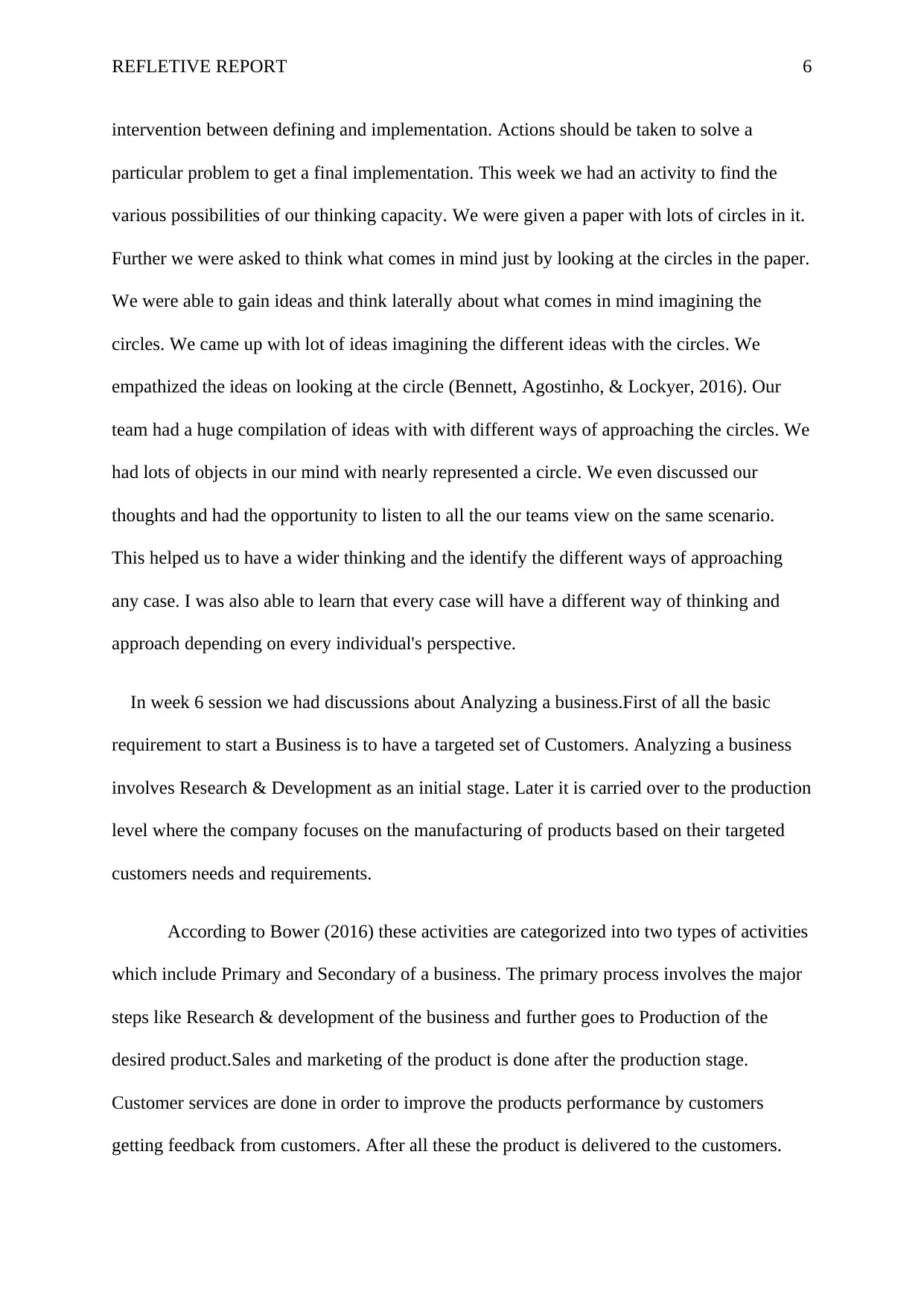
REFLETIVE REPORT 6
intervention between defining and implementation. Actions should be taken to solve a
particular problem to get a final implementation. This week we had an activity to find the
various possibilities of our thinking capacity. We were given a paper with lots of circles in it.
Further we were asked to think what comes in mind just by looking at the circles in the paper.
We were able to gain ideas and think laterally about what comes in mind imagining the
circles. We came up with lot of ideas imagining the different ideas with the circles. We
empathized the ideas on looking at the circle (Bennett, Agostinho, & Lockyer, 2016). Our
team had a huge compilation of ideas with with different ways of approaching the circles. We
had lots of objects in our mind with nearly represented a circle. We even discussed our
thoughts and had the opportunity to listen to all the our teams view on the same scenario.
This helped us to have a wider thinking and the identify the different ways of approaching
any case. I was also able to learn that every case will have a different way of thinking and
approach depending on every individual's perspective.
In week 6 session we had discussions about Analyzing a business.First of all the basic
requirement to start a Business is to have a targeted set of Customers. Analyzing a business
involves Research & Development as an initial stage. Later it is carried over to the production
level where the company focuses on the manufacturing of products based on their targeted
customers needs and requirements.
According to Bower (2016) these activities are categorized into two types of activities
which include Primary and Secondary of a business. The primary process involves the major
steps like Research & development of the business and further goes to Production of the
desired product.Sales and marketing of the product is done after the production stage.
Customer services are done in order to improve the products performance by customers
getting feedback from customers. After all these the product is delivered to the customers.
intervention between defining and implementation. Actions should be taken to solve a
particular problem to get a final implementation. This week we had an activity to find the
various possibilities of our thinking capacity. We were given a paper with lots of circles in it.
Further we were asked to think what comes in mind just by looking at the circles in the paper.
We were able to gain ideas and think laterally about what comes in mind imagining the
circles. We came up with lot of ideas imagining the different ideas with the circles. We
empathized the ideas on looking at the circle (Bennett, Agostinho, & Lockyer, 2016). Our
team had a huge compilation of ideas with with different ways of approaching the circles. We
had lots of objects in our mind with nearly represented a circle. We even discussed our
thoughts and had the opportunity to listen to all the our teams view on the same scenario.
This helped us to have a wider thinking and the identify the different ways of approaching
any case. I was also able to learn that every case will have a different way of thinking and
approach depending on every individual's perspective.
In week 6 session we had discussions about Analyzing a business.First of all the basic
requirement to start a Business is to have a targeted set of Customers. Analyzing a business
involves Research & Development as an initial stage. Later it is carried over to the production
level where the company focuses on the manufacturing of products based on their targeted
customers needs and requirements.
According to Bower (2016) these activities are categorized into two types of activities
which include Primary and Secondary of a business. The primary process involves the major
steps like Research & development of the business and further goes to Production of the
desired product.Sales and marketing of the product is done after the production stage.
Customer services are done in order to improve the products performance by customers
getting feedback from customers. After all these the product is delivered to the customers.
⊘ This is a preview!⊘
Do you want full access?
Subscribe today to unlock all pages.

Trusted by 1+ million students worldwide
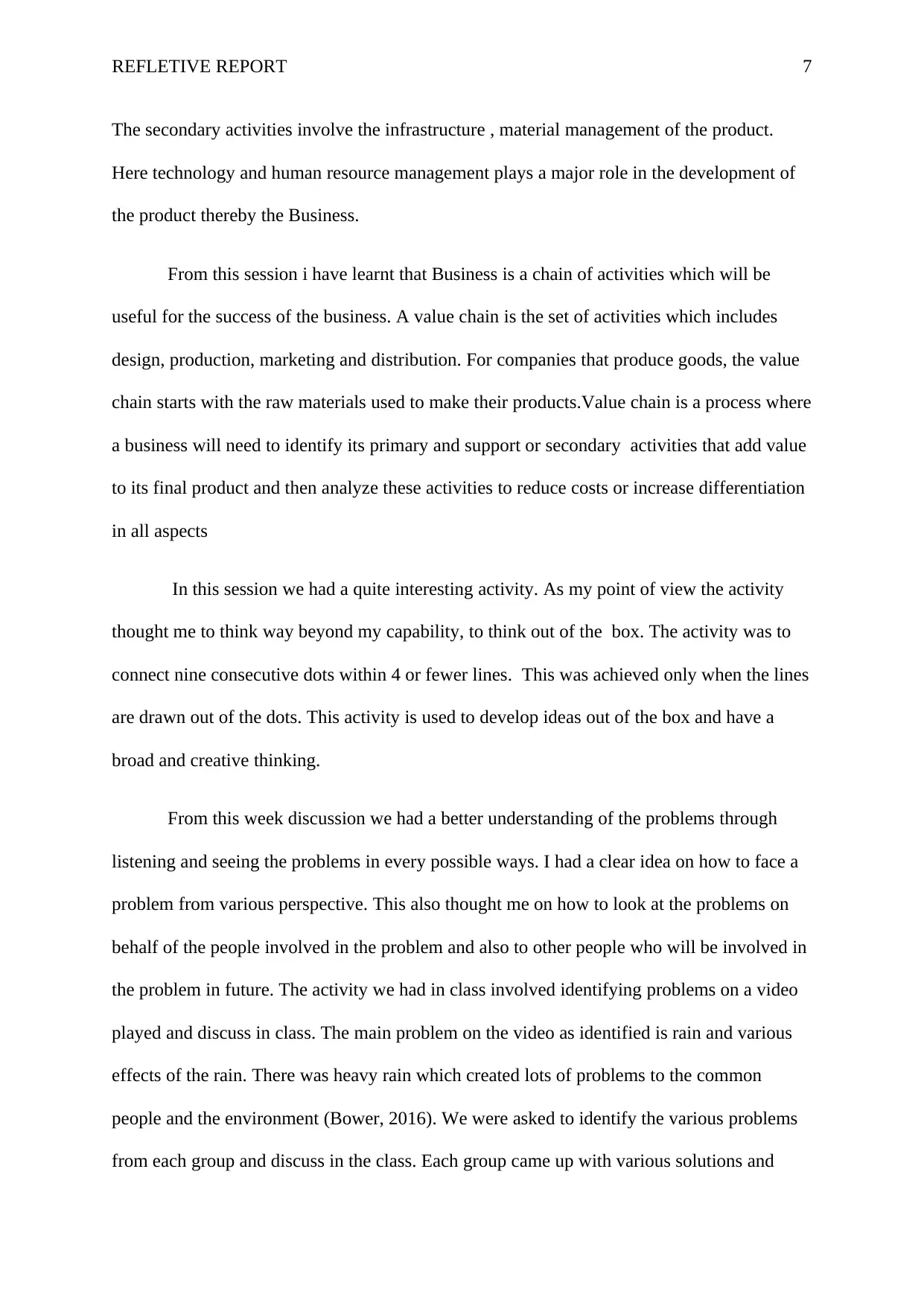
REFLETIVE REPORT 7
The secondary activities involve the infrastructure , material management of the product.
Here technology and human resource management plays a major role in the development of
the product thereby the Business.
From this session i have learnt that Business is a chain of activities which will be
useful for the success of the business. A value chain is the set of activities which includes
design, production, marketing and distribution. For companies that produce goods, the value
chain starts with the raw materials used to make their products.Value chain is a process where
a business will need to identify its primary and support or secondary activities that add value
to its final product and then analyze these activities to reduce costs or increase differentiation
in all aspects
In this session we had a quite interesting activity. As my point of view the activity
thought me to think way beyond my capability, to think out of the box. The activity was to
connect nine consecutive dots within 4 or fewer lines. This was achieved only when the lines
are drawn out of the dots. This activity is used to develop ideas out of the box and have a
broad and creative thinking.
From this week discussion we had a better understanding of the problems through
listening and seeing the problems in every possible ways. I had a clear idea on how to face a
problem from various perspective. This also thought me on how to look at the problems on
behalf of the people involved in the problem and also to other people who will be involved in
the problem in future. The activity we had in class involved identifying problems on a video
played and discuss in class. The main problem on the video as identified is rain and various
effects of the rain. There was heavy rain which created lots of problems to the common
people and the environment (Bower, 2016). We were asked to identify the various problems
from each group and discuss in the class. Each group came up with various solutions and
The secondary activities involve the infrastructure , material management of the product.
Here technology and human resource management plays a major role in the development of
the product thereby the Business.
From this session i have learnt that Business is a chain of activities which will be
useful for the success of the business. A value chain is the set of activities which includes
design, production, marketing and distribution. For companies that produce goods, the value
chain starts with the raw materials used to make their products.Value chain is a process where
a business will need to identify its primary and support or secondary activities that add value
to its final product and then analyze these activities to reduce costs or increase differentiation
in all aspects
In this session we had a quite interesting activity. As my point of view the activity
thought me to think way beyond my capability, to think out of the box. The activity was to
connect nine consecutive dots within 4 or fewer lines. This was achieved only when the lines
are drawn out of the dots. This activity is used to develop ideas out of the box and have a
broad and creative thinking.
From this week discussion we had a better understanding of the problems through
listening and seeing the problems in every possible ways. I had a clear idea on how to face a
problem from various perspective. This also thought me on how to look at the problems on
behalf of the people involved in the problem and also to other people who will be involved in
the problem in future. The activity we had in class involved identifying problems on a video
played and discuss in class. The main problem on the video as identified is rain and various
effects of the rain. There was heavy rain which created lots of problems to the common
people and the environment (Bower, 2016). We were asked to identify the various problems
from each group and discuss in the class. Each group came up with various solutions and
Paraphrase This Document
Need a fresh take? Get an instant paraphrase of this document with our AI Paraphraser

REFLETIVE REPORT 8
identical unique solutions. This helped us to look at a problem from various views and
perspective in order to come up with different solution for the issues.
In this class we had a discussion about the various factors needed for our Assessment
2. We as a team had a clear Idea of what the problem is and to find a better solution for the
chosen problem. We also were able to identify the various why's of our Idea and to proceed
further with the Assessment criteria. the session helped us to narrow down the broad way of
thinking about the idea. This made us to break down few irrelevant concepts which we had in
mind and to get to the exact appropriate point .
This week we had the opportunity to attend the presentations of our neighboring
groups as well as we had to present on the same day. By attending the session we got an idea
on what the presentation focused on and to give a better way of our ideas. This made us
understand the ultimate need of the presentation and to discuss it effectively (Ding, 2018).
We were able to understand a few areas where we went wrong. The evidence of the problem
statement was the most important aspect of the presentation. The way we use our design
thinking tools in order to evaluate the problem and solution. Each and every tool was a
reflection of each week’s lecture session which helped to go ahead with the report.
identical unique solutions. This helped us to look at a problem from various views and
perspective in order to come up with different solution for the issues.
In this class we had a discussion about the various factors needed for our Assessment
2. We as a team had a clear Idea of what the problem is and to find a better solution for the
chosen problem. We also were able to identify the various why's of our Idea and to proceed
further with the Assessment criteria. the session helped us to narrow down the broad way of
thinking about the idea. This made us to break down few irrelevant concepts which we had in
mind and to get to the exact appropriate point .
This week we had the opportunity to attend the presentations of our neighboring
groups as well as we had to present on the same day. By attending the session we got an idea
on what the presentation focused on and to give a better way of our ideas. This made us
understand the ultimate need of the presentation and to discuss it effectively (Ding, 2018).
We were able to understand a few areas where we went wrong. The evidence of the problem
statement was the most important aspect of the presentation. The way we use our design
thinking tools in order to evaluate the problem and solution. Each and every tool was a
reflection of each week’s lecture session which helped to go ahead with the report.
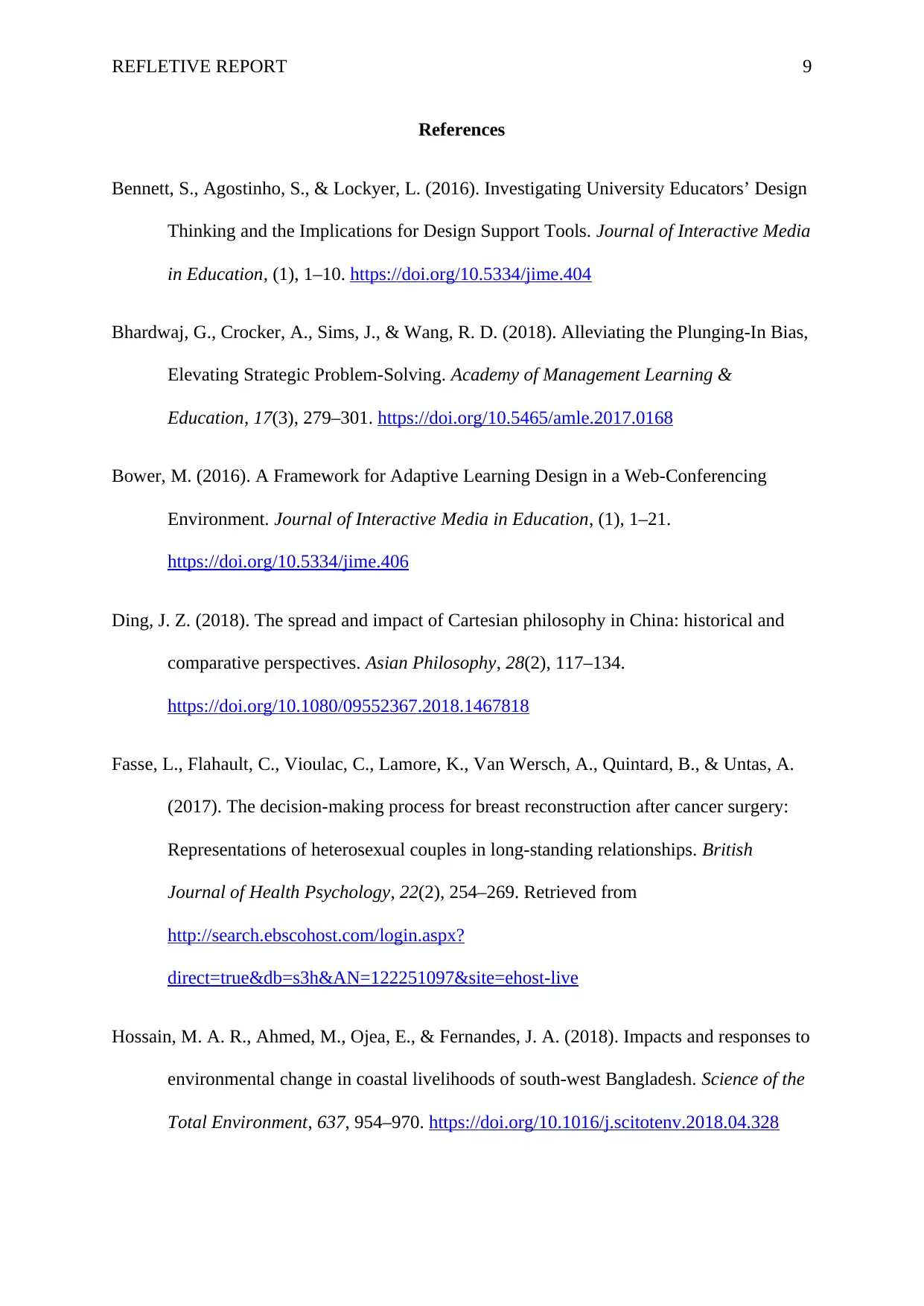
REFLETIVE REPORT 9
References
Bennett, S., Agostinho, S., & Lockyer, L. (2016). Investigating University Educators’ Design
Thinking and the Implications for Design Support Tools. Journal of Interactive Media
in Education, (1), 1–10. https://doi.org/10.5334/jime.404
Bhardwaj, G., Crocker, A., Sims, J., & Wang, R. D. (2018). Alleviating the Plunging-In Bias,
Elevating Strategic Problem-Solving. Academy of Management Learning &
Education, 17(3), 279–301. https://doi.org/10.5465/amle.2017.0168
Bower, M. (2016). A Framework for Adaptive Learning Design in a Web-Conferencing
Environment. Journal of Interactive Media in Education, (1), 1–21.
https://doi.org/10.5334/jime.406
Ding, J. Z. (2018). The spread and impact of Cartesian philosophy in China: historical and
comparative perspectives. Asian Philosophy, 28(2), 117–134.
https://doi.org/10.1080/09552367.2018.1467818
Fasse, L., Flahault, C., Vioulac, C., Lamore, K., Van Wersch, A., Quintard, B., & Untas, A.
(2017). The decision-making process for breast reconstruction after cancer surgery:
Representations of heterosexual couples in long-standing relationships. British
Journal of Health Psychology, 22(2), 254–269. Retrieved from
http://search.ebscohost.com/login.aspx?
direct=true&db=s3h&AN=122251097&site=ehost-live
Hossain, M. A. R., Ahmed, M., Ojea, E., & Fernandes, J. A. (2018). Impacts and responses to
environmental change in coastal livelihoods of south-west Bangladesh. Science of the
Total Environment, 637, 954–970. https://doi.org/10.1016/j.scitotenv.2018.04.328
References
Bennett, S., Agostinho, S., & Lockyer, L. (2016). Investigating University Educators’ Design
Thinking and the Implications for Design Support Tools. Journal of Interactive Media
in Education, (1), 1–10. https://doi.org/10.5334/jime.404
Bhardwaj, G., Crocker, A., Sims, J., & Wang, R. D. (2018). Alleviating the Plunging-In Bias,
Elevating Strategic Problem-Solving. Academy of Management Learning &
Education, 17(3), 279–301. https://doi.org/10.5465/amle.2017.0168
Bower, M. (2016). A Framework for Adaptive Learning Design in a Web-Conferencing
Environment. Journal of Interactive Media in Education, (1), 1–21.
https://doi.org/10.5334/jime.406
Ding, J. Z. (2018). The spread and impact of Cartesian philosophy in China: historical and
comparative perspectives. Asian Philosophy, 28(2), 117–134.
https://doi.org/10.1080/09552367.2018.1467818
Fasse, L., Flahault, C., Vioulac, C., Lamore, K., Van Wersch, A., Quintard, B., & Untas, A.
(2017). The decision-making process for breast reconstruction after cancer surgery:
Representations of heterosexual couples in long-standing relationships. British
Journal of Health Psychology, 22(2), 254–269. Retrieved from
http://search.ebscohost.com/login.aspx?
direct=true&db=s3h&AN=122251097&site=ehost-live
Hossain, M. A. R., Ahmed, M., Ojea, E., & Fernandes, J. A. (2018). Impacts and responses to
environmental change in coastal livelihoods of south-west Bangladesh. Science of the
Total Environment, 637, 954–970. https://doi.org/10.1016/j.scitotenv.2018.04.328
⊘ This is a preview!⊘
Do you want full access?
Subscribe today to unlock all pages.

Trusted by 1+ million students worldwide
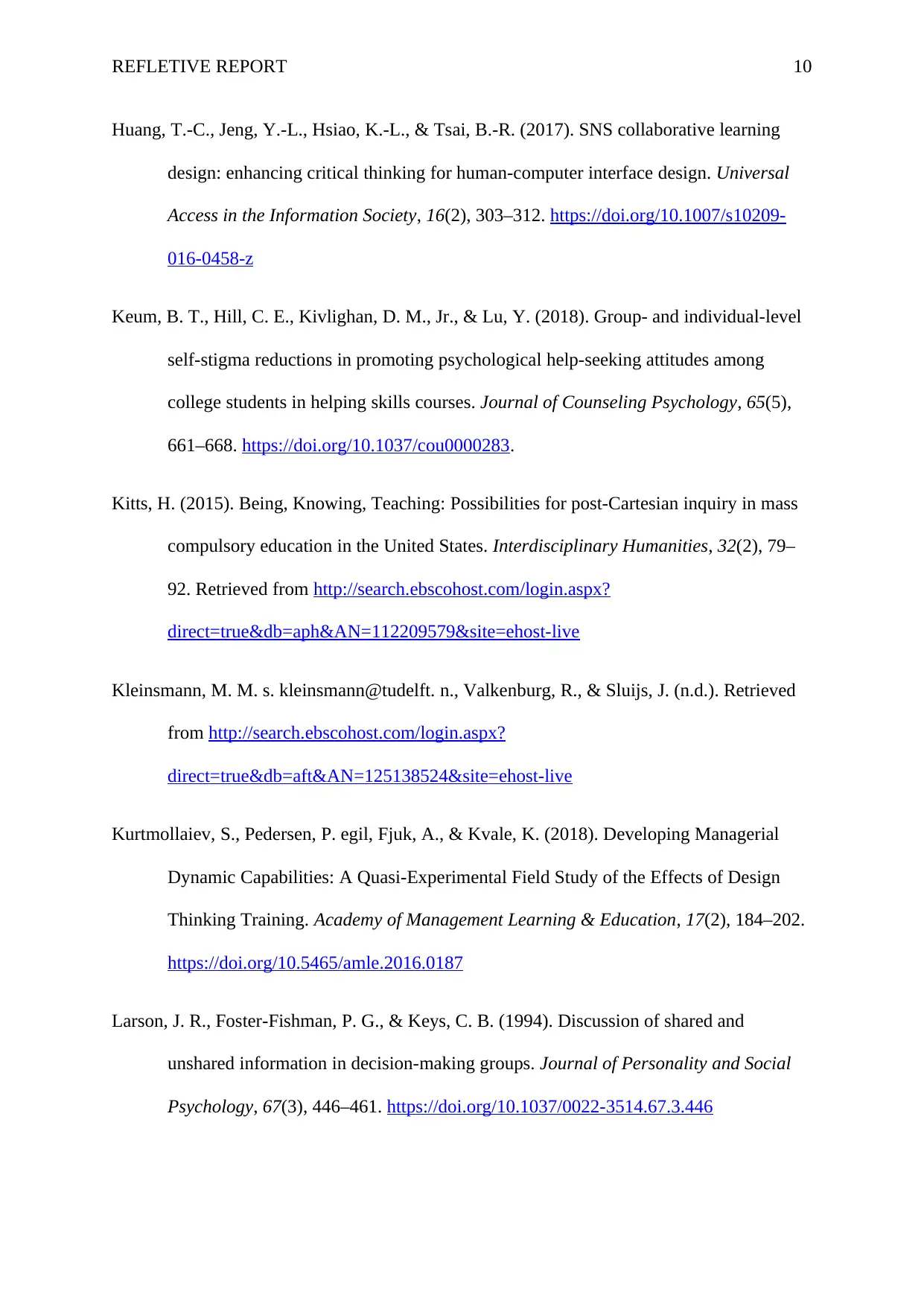
REFLETIVE REPORT 10
Huang, T.-C., Jeng, Y.-L., Hsiao, K.-L., & Tsai, B.-R. (2017). SNS collaborative learning
design: enhancing critical thinking for human-computer interface design. Universal
Access in the Information Society, 16(2), 303–312. https://doi.org/10.1007/s10209-
016-0458-z
Keum, B. T., Hill, C. E., Kivlighan, D. M., Jr., & Lu, Y. (2018). Group- and individual-level
self-stigma reductions in promoting psychological help-seeking attitudes among
college students in helping skills courses. Journal of Counseling Psychology, 65(5),
661–668. https://doi.org/10.1037/cou0000283.
Kitts, H. (2015). Being, Knowing, Teaching: Possibilities for post-Cartesian inquiry in mass
compulsory education in the United States. Interdisciplinary Humanities, 32(2), 79–
92. Retrieved from http://search.ebscohost.com/login.aspx?
direct=true&db=aph&AN=112209579&site=ehost-live
Kleinsmann, M. M. s. kleinsmann@tudelft. n., Valkenburg, R., & Sluijs, J. (n.d.). Retrieved
from http://search.ebscohost.com/login.aspx?
direct=true&db=aft&AN=125138524&site=ehost-live
Kurtmollaiev, S., Pedersen, P. egil, Fjuk, A., & Kvale, K. (2018). Developing Managerial
Dynamic Capabilities: A Quasi-Experimental Field Study of the Effects of Design
Thinking Training. Academy of Management Learning & Education, 17(2), 184–202.
https://doi.org/10.5465/amle.2016.0187
Larson, J. R., Foster-Fishman, P. G., & Keys, C. B. (1994). Discussion of shared and
unshared information in decision-making groups. Journal of Personality and Social
Psychology, 67(3), 446–461. https://doi.org/10.1037/0022-3514.67.3.446
Huang, T.-C., Jeng, Y.-L., Hsiao, K.-L., & Tsai, B.-R. (2017). SNS collaborative learning
design: enhancing critical thinking for human-computer interface design. Universal
Access in the Information Society, 16(2), 303–312. https://doi.org/10.1007/s10209-
016-0458-z
Keum, B. T., Hill, C. E., Kivlighan, D. M., Jr., & Lu, Y. (2018). Group- and individual-level
self-stigma reductions in promoting psychological help-seeking attitudes among
college students in helping skills courses. Journal of Counseling Psychology, 65(5),
661–668. https://doi.org/10.1037/cou0000283.
Kitts, H. (2015). Being, Knowing, Teaching: Possibilities for post-Cartesian inquiry in mass
compulsory education in the United States. Interdisciplinary Humanities, 32(2), 79–
92. Retrieved from http://search.ebscohost.com/login.aspx?
direct=true&db=aph&AN=112209579&site=ehost-live
Kleinsmann, M. M. s. kleinsmann@tudelft. n., Valkenburg, R., & Sluijs, J. (n.d.). Retrieved
from http://search.ebscohost.com/login.aspx?
direct=true&db=aft&AN=125138524&site=ehost-live
Kurtmollaiev, S., Pedersen, P. egil, Fjuk, A., & Kvale, K. (2018). Developing Managerial
Dynamic Capabilities: A Quasi-Experimental Field Study of the Effects of Design
Thinking Training. Academy of Management Learning & Education, 17(2), 184–202.
https://doi.org/10.5465/amle.2016.0187
Larson, J. R., Foster-Fishman, P. G., & Keys, C. B. (1994). Discussion of shared and
unshared information in decision-making groups. Journal of Personality and Social
Psychology, 67(3), 446–461. https://doi.org/10.1037/0022-3514.67.3.446
Paraphrase This Document
Need a fresh take? Get an instant paraphrase of this document with our AI Paraphraser
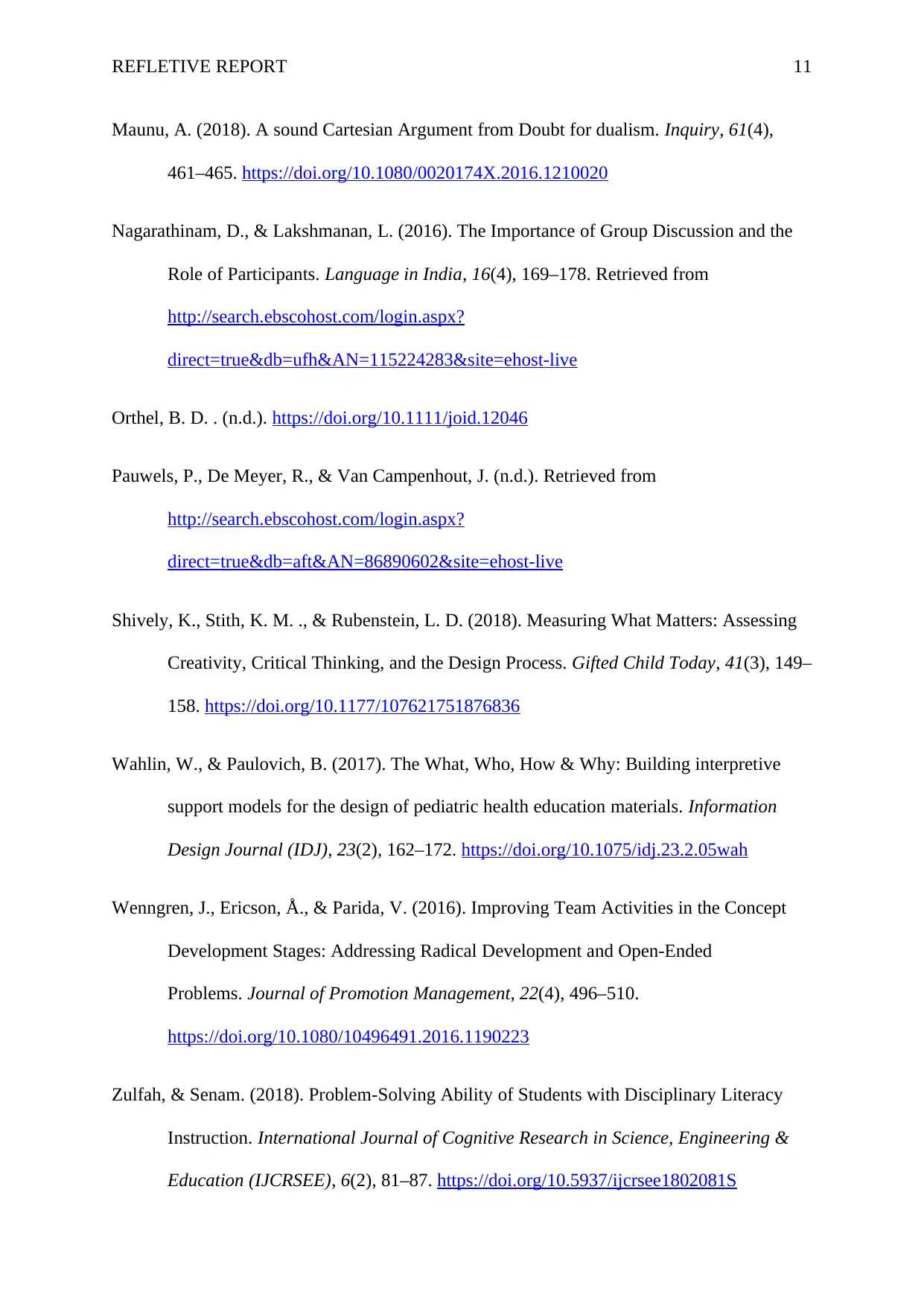
REFLETIVE REPORT 11
Maunu, A. (2018). A sound Cartesian Argument from Doubt for dualism. Inquiry, 61(4),
461–465. https://doi.org/10.1080/0020174X.2016.1210020
Nagarathinam, D., & Lakshmanan, L. (2016). The Importance of Group Discussion and the
Role of Participants. Language in India, 16(4), 169–178. Retrieved from
http://search.ebscohost.com/login.aspx?
direct=true&db=ufh&AN=115224283&site=ehost-live
Orthel, B. D. . (n.d.). https://doi.org/10.1111/joid.12046
Pauwels, P., De Meyer, R., & Van Campenhout, J. (n.d.). Retrieved from
http://search.ebscohost.com/login.aspx?
direct=true&db=aft&AN=86890602&site=ehost-live
Shively, K., Stith, K. M. ., & Rubenstein, L. D. (2018). Measuring What Matters: Assessing
Creativity, Critical Thinking, and the Design Process. Gifted Child Today, 41(3), 149–
158. https://doi.org/10.1177/107621751876836
Wahlin, W., & Paulovich, B. (2017). The What, Who, How & Why: Building interpretive
support models for the design of pediatric health education materials. Information
Design Journal (IDJ), 23(2), 162–172. https://doi.org/10.1075/idj.23.2.05wah
Wenngren, J., Ericson, Å., & Parida, V. (2016). Improving Team Activities in the Concept
Development Stages: Addressing Radical Development and Open-Ended
Problems. Journal of Promotion Management, 22(4), 496–510.
https://doi.org/10.1080/10496491.2016.1190223
Zulfah, & Senam. (2018). Problem-Solving Ability of Students with Disciplinary Literacy
Instruction. International Journal of Cognitive Research in Science, Engineering &
Education (IJCRSEE), 6(2), 81–87. https://doi.org/10.5937/ijcrsee1802081S
Maunu, A. (2018). A sound Cartesian Argument from Doubt for dualism. Inquiry, 61(4),
461–465. https://doi.org/10.1080/0020174X.2016.1210020
Nagarathinam, D., & Lakshmanan, L. (2016). The Importance of Group Discussion and the
Role of Participants. Language in India, 16(4), 169–178. Retrieved from
http://search.ebscohost.com/login.aspx?
direct=true&db=ufh&AN=115224283&site=ehost-live
Orthel, B. D. . (n.d.). https://doi.org/10.1111/joid.12046
Pauwels, P., De Meyer, R., & Van Campenhout, J. (n.d.). Retrieved from
http://search.ebscohost.com/login.aspx?
direct=true&db=aft&AN=86890602&site=ehost-live
Shively, K., Stith, K. M. ., & Rubenstein, L. D. (2018). Measuring What Matters: Assessing
Creativity, Critical Thinking, and the Design Process. Gifted Child Today, 41(3), 149–
158. https://doi.org/10.1177/107621751876836
Wahlin, W., & Paulovich, B. (2017). The What, Who, How & Why: Building interpretive
support models for the design of pediatric health education materials. Information
Design Journal (IDJ), 23(2), 162–172. https://doi.org/10.1075/idj.23.2.05wah
Wenngren, J., Ericson, Å., & Parida, V. (2016). Improving Team Activities in the Concept
Development Stages: Addressing Radical Development and Open-Ended
Problems. Journal of Promotion Management, 22(4), 496–510.
https://doi.org/10.1080/10496491.2016.1190223
Zulfah, & Senam. (2018). Problem-Solving Ability of Students with Disciplinary Literacy
Instruction. International Journal of Cognitive Research in Science, Engineering &
Education (IJCRSEE), 6(2), 81–87. https://doi.org/10.5937/ijcrsee1802081S

REFLETIVE REPORT 12
⊘ This is a preview!⊘
Do you want full access?
Subscribe today to unlock all pages.

Trusted by 1+ million students worldwide
1 out of 12
Related Documents
Your All-in-One AI-Powered Toolkit for Academic Success.
+13062052269
info@desklib.com
Available 24*7 on WhatsApp / Email
![[object Object]](/_next/static/media/star-bottom.7253800d.svg)
Unlock your academic potential
Copyright © 2020–2025 A2Z Services. All Rights Reserved. Developed and managed by ZUCOL.




